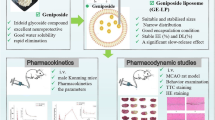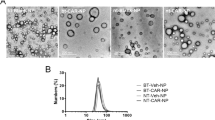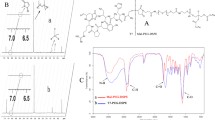Abstract
There is insufficient evidence on the effect of nanoparticles, particularly liposomes loaded with a statin, on acute ischemic stroke. We investigated the impact of atorvastatin-loaded PEG (polyethylene glycol) conjugated liposomes (LipoStatin) on the outcomes in rats with cerebral ischemia–reperfusion. PEGylated liposome loaded with atorvastatin was developed as a nanoparticle to specifically accumulate in an ischemic region and release the drug to ameliorate the harmful effects of the stroke. LipoStatin was administered to rats with transient middle cerebral artery occlusion through the tail vein immediately after reperfusion (LipoStatin group). LipoStatin efficiently accumulated at the cerebral ischemic injury site of the rat. The LipoStatin group showed a significantly reduced infarct volume (p < 0.01) in brain micro-MR imaging and improved neurological function recovery compared to the control group (p < 0.05). In addition, markedly improved brain metabolism using fluorine-18 fluorodeoxyglucose micro-PET/CT imaging was demonstrated in the LipoStatin group compared with the control group (p < 0.01). Mechanistically, as a result of evaluation through IL-1 beta, TNF-alpha, ICAM-1, and Iba-1 mRNA expression levels at 5 days after cerebral ischemia, LipoStatin showed significant anti-inflammatory effects. Protein expression of occludin, JAM-A, Caveolin-1, and eNOS by western blot at 3 days and fluorescent images at 7 days showed considerable recovery of blood–brain barrier breakdown and endothelial dysfunction. PEGylated LipoStatin can be more effectively delivered to the ischemic brain and may have significant neuroprotective effects. Thus, PEGylated LipoStatin can be further developed as a promising targeted therapy for ischemic stroke and other major vascular diseases.







Similar content being viewed by others
Data Availability
All supporting data for the article are available upon reasonable request from a qualified investigator.
Code Availability
Not applicable.
References
Korea VSDS, Shin H-Y, Kim J, Lee S, Park MS, Park S, et al. Cause-of-death statistics in 2018 in the Republic of Korea. J Korean Med Assoc. 2020;63(5):286–97. https://doi.org/10.5124/jkma.2020.63.5.286.
Powers WJ, Rabinstein AA, Ackerson T, Adeoye OM, Bambakidis NC, Becker K, et al. 2018 Guidelines for the early management of patients with acute ischemic stroke: a guideline for healthcare professionals from the American Heart Association/American Stroke Association. Stroke. 2018;49(3):e46–110. https://doi.org/10.1161/str.0000000000000158.
Goyal M, Menon BK, van Zwam WH, Dippel DW, Mitchell PJ, Demchuk AM, et al. Endovascular thrombectomy after large-vessel ischaemic stroke: a meta-analysis of individual patient data from five randomised trials. Lancet (London, England). 2016;387(10029):1723–31. https://doi.org/10.1016/s0140-6736(16)00163-x.
Chen J, Jin J, Li K, Shi L, Wen X, Fang F. Progresses and prospects of neuroprotective agents-loaded nanoparticles and biomimetic material in ischemic stroke. Front Cell Neurosci. 2022;16:868323. https://doi.org/10.3389/fncel.2022.868323.
Dong X, Gao J, Su Y, Wang Z. Nanomedicine for ischemic stroke. Int J Mol Sci. 2020;21(20):7600.
Shi L, Zhang J, Zhao M, Tang S, Cheng X, Zhang W, et al. Effects of polyethylene glycol on the surface of nanoparticles for targeted drug delivery. Nanoscale. 2021;13(24):10748–64. https://doi.org/10.1039/d1nr02065j.
Askarizadeh A, Butler AE, Badiee A, Sahebkar A. Liposomal nanocarriers for statins: a pharmacokinetic and pharmacodynamics appraisal. J Cell Physiol. 2019;234(2):1219–29. https://doi.org/10.1002/jcp.27121.
High-dose atorvastatin after stroke or transient ischemic attack. N Engl J Med. 2006;355(6):549–59. https://doi.org/10.1056/NEJMoa061894.
Hong H, Zeng JS, Kreulen DL, Kaufman DI, Chen AF. Atorvastatin protects against cerebral infarction via inhibition of NADPH oxidase-derived superoxide in ischemic stroke. Am J Physiol Heart Circ Physiol. 2006;291(5):H2210–5. https://doi.org/10.1152/ajpheart.01270.2005.
Vaughan CJ, Delanty N. Neuroprotective properties of statins in cerebral ischemia and stroke. Stroke. 1999;30(9):1969–73. https://doi.org/10.1161/01.STR.30.9.1969.
Naci H, Brugts JJ, Fleurence R, Tsoi B, Toor H, Ades A. Comparative benefits of statins in the primary and secondary prevention of major coronary events and all-cause mortality: a network meta-analysis of placebo-controlled and active-comparator trials. Eur J Prev Cardiol. 2013;20(4):641–57. https://doi.org/10.1177/2047487313480435.
Sicard KM, Fisher M. Animal models of focal brain ischemia. Exp Transl Stroke Med. 2009;1:7. https://doi.org/10.1186/2040-7378-1-7.
Jeong YJ, Cheon S-M, Kang D-Y, Kim JW. F-18 FP-CIT PET in multiple system atrophy of the cerebellar type: additional role in treatment. Contrast Media; Mol Imaging. 2017;2017:8598705. https://doi.org/10.1155/2017/8598705.
Rodríguez-Yáñez M, Castillo J. Role of inflammatory markers in brain ischemia. Curr Opin Neurol. 2008;21(3):353–7. https://doi.org/10.1097/WCO.0b013e3282ffafbf.
Rezaie-Majd A, Prager GW, Bucek RA, Schernthaner GH, Maca T, Kress H-G, et al. Simvastatin reduces the expression of adhesion molecules in circulating monocytes from hypercholesterolemic patients. Arterioscler Thromb Vasc Biol. 2003;23(3):397–403. https://doi.org/10.1161/01.ATV.0000059384.34874.F0.
Ito D, Tanaka K, Suzuki S, Dembo T, Fukuuchi Y. Enhanced expression of Iba1, ionized calcium-binding adapter molecule 1, after transient focal cerebral ischemia in rat brain. Stroke. 2001;32(5):1208–15. https://doi.org/10.1161/01.str.32.5.1208.
Wei G, Dawson VL, Zweier JL. Role of neuronal and endothelial nitric oxide synthase in nitric oxide generation in the brain following cerebral ischemia. Biochem Biophys Acta. 1999;1455(1):23–34. https://doi.org/10.1016/s0925-4439(99)00051-4.
Huang Q, Zhong W, Hu Z, Tang X. A review of the role of cav-1 in neuropathology and neural recovery after ischemic stroke. J Neuroinflammation. 2018;15(1):348. https://doi.org/10.1186/s12974-018-1387-y.
Zarruk JG, Garcia-Yebenes I, Romera VG, Ballesteros I, Moraga A, Cuartero MI, et al. Neurological tests for functional outcome assessment in rodent models of ischaemic stroke. Rev Neurol. 2011;53(10):607–18.
The rotarod test. an evaluation of its effectiveness in assessing motor deficits following traumatic brain injury. J Neurotrauma. 1994;11(2):187–96. https://doi.org/10.1089/neu.1994.11.187.
Selim MH, Molina CA. High-dose statin for every stroke. Stroke. 2012;43(7):1996–7. https://doi.org/10.1161/STROKEAHA.111.648832.
Kleindorfer DO, Towfighi A, Chaturvedi S, Cockroft KM, Gutierrez J, Lombardi-Hill D, et al. Guideline for the prevention of stroke in patients with stroke and transient ischemic attack: a guideline from the American Heart Association/American Stroke Association. Stroke. 2021;52(7):e364–467. https://doi.org/10.1161/STR.0000000000000375.
Laufs U, Gertz K, Huang P, Nickenig G, Bohm M, Dirnagl U, et al. Atorvastatin upregulates type III nitric oxide synthase in thrombocytes, decreases platelet activation, and protects from cerebral ischemia in normocholesterolemic mice. Stroke. 2000;31(10):2442–9. https://doi.org/10.1161/01.str.31.10.2442.
Saito T, Nito C, Ueda M, Inaba T, Kamiya F, Muraga K, et al. Continuous oral administration of atorvastatin ameliorates brain damage after transient focal ischemia in rats. Life Sci. 2014;94(2):106–14. https://doi.org/10.1016/j.lfs.2013.11.018.
Fang X, Tao D, Shen J, Wang Y, Dong X, Ji X. Neuroprotective effects and dynamic expressions of MMP9 and TIMP1 associated with atorvastatin pretreatment in ischemia-reperfusion rats. Neurosci Lett. 2015;603:60–5. https://doi.org/10.1016/j.neulet.2015.07.013.
Nenna A, Nappi F, Larobina D, Verghi E, Chello M, Ambrosio L. Polymers and nanoparticles for statin delivery: current use and future perspectives in cardiovascular disease. Polymers. 2021;13(5). https://doi.org/10.3390/polym13050711.
Juhairiyah F, de Lange ECM. Understanding drug delivery to the brain using liposome-based strategies: studies that provide mechanistic insights are essential. AAPS J. 2021;23(6):114. https://doi.org/10.1208/s12248-021-00648-z.
Vieira DB, Gamarra LF. Getting into the brain: liposome-based strategies for effective drug delivery across the blood-brain barrier. Int J Nanomedicine. 2016;11:5381–414. https://doi.org/10.2147/IJN.S117210.
Liu S, Levine SR, Winn HR. Targeting ischemic penumbra Part II: selective drug delivery using liposome technologies. J Exp Stroke Transl Med. 2011;4(1):16–23. https://doi.org/10.6030/1939-067x-4.1.16.
Han X, Ren H, Nandi A, Fan X, Koehler RC. Analysis of glucose metabolism by 18F-FDG-PET imaging and glucose transporter expression in a mouse model of intracerebral hemorrhage. Sci Rep. 2021;11(1):10885. https://doi.org/10.1038/s41598-021-90216-4.
Endres M, Laufs U, Huang Z, Nakamura T, Huang P, Moskowitz MA, et al. Stroke protection by 3-hydroxy-3-methylglutaryl (HMG)-CoA reductase inhibitors mediated by endothelial nitric oxide synthase. Proc Natl Acad Sci. 1998;95(15):8880–5. https://doi.org/10.1073/pnas.95.15.8880.
Kosmidou I, Moore JP, Weber M, Searles CD. Statin treatment and 3′ polyadenylation of eNOS mRNA. Arterioscler Thromb Vasc Biol. 2007;27(12):2642–9. https://doi.org/10.1161/atvbaha.107.154492.
Churchward MA, Todd KG. Statin treatment affects cytokine release and phagocytic activity in primary cultured microglia through two separable mechanisms. Mol Brain. 2014;7:85. https://doi.org/10.1186/s13041-014-0085-7.
Pan R, Yu K, Weatherwax T, Zheng H, Liu W, Liu KJ. Blood occludin level as a potential biomarker for early blood brain barrier damage following ischemic stroke. Sci Rep. 2017;7(1):40331. https://doi.org/10.1038/srep40331.
Pan R, Yu K, Weatherwax T, Zheng H, Liu W, Liu KJ. Blood occludin level as a potential biomarker for early blood brain barrier damage following ischemic stroke. Sci Rep. 2017;7:40331. https://doi.org/10.1038/srep40331.
Yang D, Knight RA, Han Y, Karki K, Zhang J, Chopp M, et al. Statins protect the blood brain barrier acutely after experimental intracerebral hemorrhage. J Behav Brain Sci. 2013;3(1):100–6. https://doi.org/10.4236/jbbs.2013.31010.
Fukuta T, Oku N, Kogure K. Application and utility of liposomal neuroprotective agents and biomimetic nanoparticles for the treatment of ischemic stroke. Pharmaceutics. 2022;14(2). https://doi.org/10.3390/pharmaceutics14020361.
Ishii T, Asai T, Oyama D, Agato Y, Yasuda N, Fukuta T, et al. Treatment of cerebral ischemia-reperfusion injury with PEGylated liposomes encapsulating FK506. FASEB J. 2013;27(4):1362–70. https://doi.org/10.1096/fj.12-221325.
Wang Z, Zhao Y, Jiang Y, Lv W, Wu L, Wang B, et al. Enhanced anti-ischemic stroke of ZL006 by T7-conjugated PEGylated liposomes drug delivery system. Sci Rep. 2015;5:12651. https://doi.org/10.1038/srep12651.
Funding
This work was supported by the Technology Innovation Program (or Industrial Strategic Technology Development Program-Development of Core Industrial Technology) (20003822, Development of Navigation System Technologies of MicroNano Robots with Drug for Brain Disease Therapy) funded By the Ministry of Trade, Industry & Energy (MOTIE, Korea). This work was supported by a National Research Foundation of Korea Grant funded by the Korean Government (NRF-2021M3C1B8036779).
Author information
Authors and Affiliations
Corresponding authors
Ethics declarations
Ethics Approval
An institutional review board approved this study.
Consent for Publication
Not applicable.
Conflict of Interest
The authors declare no competing interests.
Additional information
Publisher's note
Springer Nature remains neutral with regard to jurisdictional claims in published maps and institutional affiliations.
Supplementary Information
Below is the link to the electronic supplementary material.
Rights and permissions
Springer Nature or its licensor (e.g. a society or other partner) holds exclusive rights to this article under a publishing agreement with the author(s) or other rightsholder(s); author self-archiving of the accepted manuscript version of this article is solely governed by the terms of such publishing agreement and applicable law.
About this article
Cite this article
Thomas, R.G., Kim, Jh., Kim, Jh. et al. Treatment of Ischemic Stroke by Atorvastatin-Loaded PEGylated Liposome. Transl. Stroke Res. 15, 388–398 (2024). https://doi.org/10.1007/s12975-023-01125-9
Received:
Revised:
Accepted:
Published:
Issue Date:
DOI: https://doi.org/10.1007/s12975-023-01125-9




